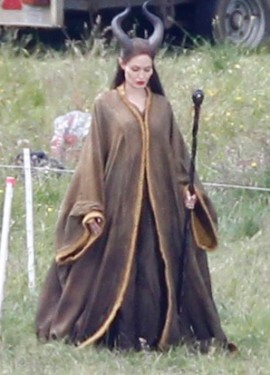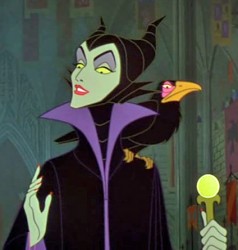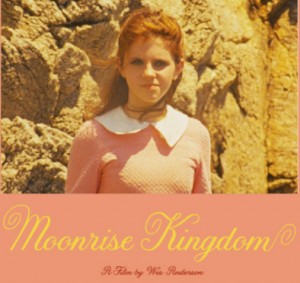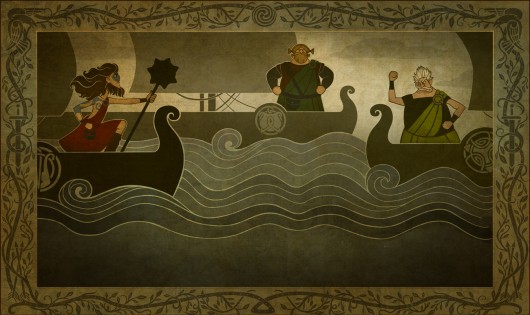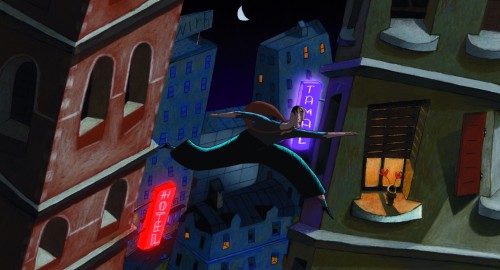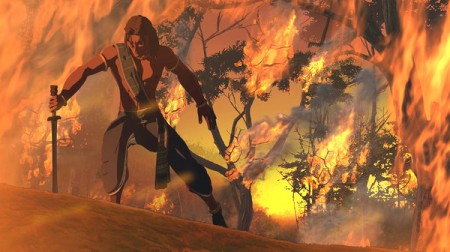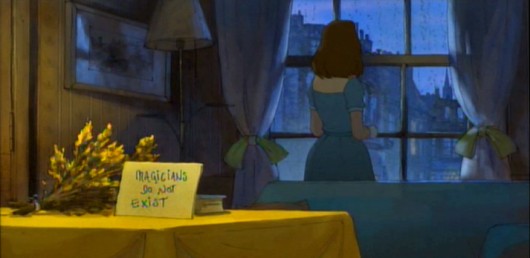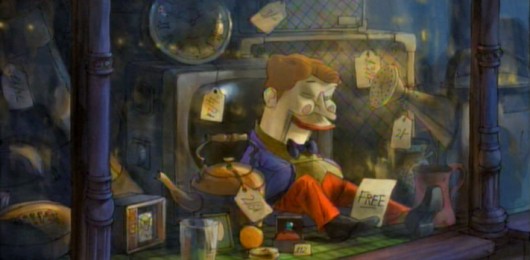Category ArchiveCommentary
Commentary 23 Jun 2012 05:36 am
Sarris & Scher & Assorted Other Things
 - When I was in the Navy, 1970 to be exact, I was stationed in Adak Alaska. Adak is a small island centrally located in the Aleutian Islands. There were 250 of us on the island, separated from the principal part of the base by seven miles. A very tough ride to make on days off – if weather allowed it. Not only did I feel separated from the real world, I was.
- When I was in the Navy, 1970 to be exact, I was stationed in Adak Alaska. Adak is a small island centrally located in the Aleutian Islands. There were 250 of us on the island, separated from the principal part of the base by seven miles. A very tough ride to make on days off – if weather allowed it. Not only did I feel separated from the real world, I was.
Out of the blue, one day, I received a wonderful little package. It was copy of Andrew Sarris‘ giant of a book, The American Cinema: Directors and Directions 1929-1968. Sarris was the film critic for the Village Voice. He had introduced America to the French idea, the auteur theory of film criticism. This theory flatly stated that it was the film’s director who authored movies.
Back then, this new idea was mocked. It was easy to appreciate such thoughts about Europeans like Bergman, Truffaut or Rossellini. But how ridiculous to bestow entertainers like Hitchcock, Ford or Hawks with such esteem.
During the 60s, 70s & 80s, Sarris and Pauline Kael conducted bitter and open arguments about film theory. John Simon and Stanley Kaufman were often participants in these debates which often lifted the evaluation of many films and made film theory and criticism almost an art in its own rite.
I, personally, was just beginning to shape my thoughts about film. Sarris came to me at the perfect time. The book was broken into a number of categories like “Pantheon,” “Expressive Esoterica,” or “Less than meets the eye.” Within these categories some 200 American film directors are ranked, and more than 6000 films are evaluated. I didn’t know who many of the directors were nor had I even heard of the majority of the films.
However, I was so taken by the book’s content that I reread it at least a half dozen times – over and over and over. Having consumed the book, I rushed back to it as reference any time I saw a film or read about a director. I just about memorized what Sarris had to say about many many American film directors. What’s more I often agreed with Sarris as my opinions grew stronger.
The book directed me to a full knowledge of American cinema and a strong appreciation of its history. First I have to thank my friend, jim Weslowski, for sending me the book, but, foremost, I thank Sarris for all the information and film theory he’s given me.
I write this only a couple of days after Andrew Sarris has died of complications from an infection after a fall. Reading this news disheartened me. He was among the “Pantheon” of film critics. He didn’t resort to thumbs up or down; he turned to words which could help educate us about the Art of Film. Everything smart and good seems to be passing.
- I’ve been reading the local reviews of Brave and have found hem interesting. They seem to break into two types:
there are those that casually give it 2 or three stars and add another 500 words.
Then there are those that go into depth and analyze the film’s story and substance, including all the elements that make up the film.
It would seem that those who give the film more space seem to like it more than the quick-star reviews.
The two I particularly liked were Manohla Dargis’ review in the NYTimes.
 “The riotous mass of bouncy curls that crowns Merida, the free-to-be-me heroine of the new Pixar movie, “Brave,†is a marvel of computer imagineering.”
“The riotous mass of bouncy curls that crowns Merida, the free-to-be-me heroine of the new Pixar movie, “Brave,†is a marvel of computer imagineering.”“Merida is active instead of passive, a doer rather than a gal who hangs around the castle waiting for Prince Charming to rescue her. More to the point and to the movie’s marketing, she is Pixar’s first female protagonist, which means that there’s a lot more riding on her head than that ginger mop.”
“Merida doesn’t dream that her prince will come; she doesn’t have to because it’s clear that, within the logic of the movie, the alternative is comically unthinkable. It’s no great surprise that she wins the struggle to determine her fate. But hers is a contingent freedom won with smiles, acquiescence and a literal needle and thread with which she neatly sews up the story, repairing a world where girls and women know exactly where they stand. “
and Melissa Anderson‘s review in the Village Voice.
- “Advancing the story’s Grimm-like grimness is a suitably dark color palette, hues that sometimes suggest Rorschach inkblots. For all female audience members with memories of their struggles of individuation from their mothers, Brave is its own kind of psychological projective test. But again, as convention dictates, these almost-unbearable horrors—a child’s guilt over turning a parent into something unrecognizable, of “destroying” her family—are quickly ameliorated, as Merida sets out to ‘mend a bond torn by pride.’ “
- The indomitable animation artist, Jeff Scher, has a new OpEd piece on the NYTimes. Summer Sketches. To quote Jeff: “Water is the most animated substance on the planet, and when I’m not drawing it or painting with it (watercolor) I often find myself photographing it.” Water, this is the heart of the film.
I’m a bit disappointed that the score is not by Shay Lynch – Mr. Scher’s pieces have brought me two artists, both Jeff Scher and composer, Shay Lynch. However, this score is taken from “. . . the first movement of Viktor Ullmann’s Piano Sonata No.7, performed by the concert pianist — and my old friend — Paul Orgel.” Orgel was killed in Auschwitz by the Nazis in 1944, and this sonata was never completed.
The film is short, take a look.
- There was a shot of Angelina Jolie photographed as Maleficent this past week. However it was a tight closeup that didn’t reveal very much. Then the newspapers offered more in the photos on Friday. The pics were from a British tabloid, so they’ve no doubt, been circulated. The one, above, was among them.
The brown costume seems wrong to me, but what do I know? As a matter of fact, another fairy tale named after the villain of the piece tells me a lot about how they’re all going wrong. A bunch of poor movies. Disney, rerelease Sleeping Beauty in 70mm and save yourself a lot of money instead of making a vanity piece for Ms. Jolie.
- I wrote a bit about Brad Bird the other day.
Harvey Deneroff has a good interview with him on
his site, harvey@deneroff.com.
The interview was conducted when The Iron Giant had just started production.
- On his site, Oswald Iten writes about Wes Anderson‘s animation for Moonrise Kingdom. It seems that the producer, director of The Fantastic Mr. Fox, is still in love with animation. In his new film, Moonrise Kingdom, his character reads aloud short snippets of several books she’s been reading. Originally, Anderson had planned just to show the books produced for the film, but ultimately he decided – regardless of the fact that they are not seen in the film – to animate the story bits. Here‘s the link to the animation.
I haven’t seen this information elsewhere, so I’m glad I read it on Oswald’s blog. He also writes in another post about the Anderson film, and its well worth reading (especially if you’re a fan of Mr. Anderson’s work.)
Commentary &Daily post 21 Jun 2012 06:21 am
Brave
- I saw Pixar’s Brave on Tuesday night. It’s not a perfect film, but it’s certainly the best film they’ve done since Ratatouille. I have my share of complaints but was quite surprised it’s as good a film as it is. Let’s start off with the story.
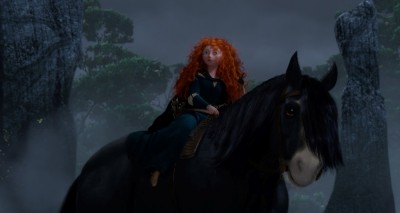 I was surprised the story isn’t quite as cliched as I expected. As a matter of fact, there are many things that aren’t expected in the story, and it turns in some unusual ways that are very positive.
I was surprised the story isn’t quite as cliched as I expected. As a matter of fact, there are many things that aren’t expected in the story, and it turns in some unusual ways that are very positive.
Probably giving away some spoilers, the story is this: A young, immature Scottish princess follows the lead of her father as she tries to make herself into a tomboy warrior, an expert archer, while her mother continually cajoles her into acting properly as a princess should. Things build to a head when her mother sets up three suitors to meet with her hoping to find a future husband for the girl, Merida.
Merida contacts a witch for a spell to transform the mother, to get mom off her back. But the potion, of course, runs afoul of the plan when it turns the mother into something unexpected. The plot thickens, as they have 48 hours to break the spell.
Up to the introduction of the witch character (who reminds me both of Andreas Deja’s Madame Odie from the Princess and the Frog and the Mad Madame Mim from Sword in the Stone), the story is thoroughly entertaining. It takes an obvious turn or two, then it gets wonderful again with focus on the Queen Mother. This is the best and funniest animation in the film. She’s a wonderful character who reminds me a bit of a minor but delightful Chuck Jones character.
The ending is forced as all the men are given short shrift; they act like dolts for the last third of the film. There isn’t one male in the film that we can look up to. In fact, the father who starts out as a strong and solid heroic type, with a subtle and charming character, turns fool like all the other males. Merida rejects the suitors out of the box, yet they’re all doofish and unattractive characters. It would have made more sense to have one of them look the part of a hero, then the girl’s rejection would make more intellectual sense. As it is, she’d be an idiot to accept any of them (and you have to wonder about the parents expecting her to marry any of these guys.)
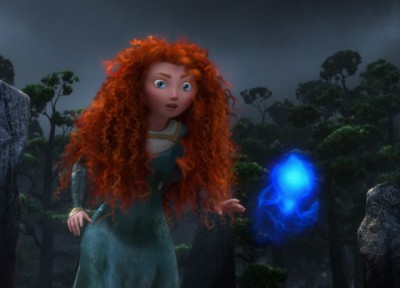 The film steals from a number of different other animation films. There’s the scene from Sword in the Stone where Wart chases an arrow into the woods. Merida does the same here until she meets up with a wood sprite. They steal from Miyazaki often in a very obvious fashion. Sprites taken from Princess Mononoke dominate woodland scenes and bring the Celtic magic to the forest.
The film steals from a number of different other animation films. There’s the scene from Sword in the Stone where Wart chases an arrow into the woods. Merida does the same here until she meets up with a wood sprite. They steal from Miyazaki often in a very obvious fashion. Sprites taken from Princess Mononoke dominate woodland scenes and bring the Celtic magic to the forest.
The real magic of the film comes when the mother is transformed, and they steal away to the woods to try to get the witch to change her spell. At one point the Pixar people have struck gold as they’ve dug into a real fairy tale that they’ve created. It’s right out of Russian or Germanic mythology, and it feels like real magic. It almost feels as though a tapestry has come to life. For this moment, the film truly soars.However, we’re very soon out of this magical moment and back to the world of the animated ordinary. The finale feels tagged onto what has been such a fine film through the first hour or so.
One would like to know what Brenda Chapman did before being replaced by Mark Andrews. I know that the film took place in snow throughout Chapman’s cut, and that was altered. I also know that the film’s title was originally The Bear and the Bow, which is a much more appropriate title. It hints at the notion of folk legend, and it has everything to do with the story. The title, Brave, makes no sense in the film I saw though there are a couple of lame attempts to justify it..
Generally, the acting – meaning the animation – in the film is better than recent other Pixar films, with the animation of the transformed Queen nothing short of wonderful. Merida’s horse is also solidly done with a strong and real character. They don’t try to anthropomorphize the character as was done in Tangled, and it’s a strong choice. The principals, Merida and her two parents, have been imbued with strong and complex character, and I enjoyed watching it develop. Whereas the father falls apart quickly, as I said, Merida’s personality continues to unfold right up to the end. The voice work is also brilliantly performed. Kelly McDonald is exceptional in her part as Merida as is Emma Thompson as the mother. Billy Connolly is also strong as the father, until the last third of the film when he can only read the lines he’s fed.
This is, as I said, my favorite Pixar film since Ratatouille, and I must admit after seeing recent films from them, I am surprised. It gives me a bit of hope. Congratulations to all who worked on it. CGI moves another step forward. I think Monsters 2 is up next. One step forward and . . .
Art Art &Commentary 16 Jun 2012 06:06 am
Promises
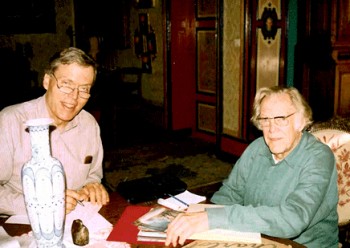 - I don’t know about you, but I love to read interviews. The longer the better. When things go a while and there’s been nothing available, I’ll turn to Mike Barrier‘s site and find something in the archive to reread. For my money, the animation interviews he posts are by far the best available to me. There’s so much in his interview scripts that even rereading for the fifth or sixth time, there’s still plenty to be gleaned in them. I’ve certainly read the _________________Barrier & John McGrew
- I don’t know about you, but I love to read interviews. The longer the better. When things go a while and there’s been nothing available, I’ll turn to Mike Barrier‘s site and find something in the archive to reread. For my money, the animation interviews he posts are by far the best available to me. There’s so much in his interview scripts that even rereading for the fifth or sixth time, there’s still plenty to be gleaned in them. I’ve certainly read the _________________Barrier & John McGrew
John Hubley, John McGrew and
David Hand interviews more than six times. You’d think I’d be taking notes, by now. No, I just enjoy them as reading material. It’s almost like rereading a Barbara Pym novel, I gobble them up and absorb the characters at play; I enjoy the thrust of the lives in discussion and it doesn’t matter that I know where the story is going. Of course, it helps a lot that I have a real interest in the players and what they’ve gone through, and, in fact, I’ve known a few of them. Many of the others, i feel as though I’ve known them from reading about them and/or studying their work.
Somehow it’s more fun to me to read them rather than listen to audio recordings of them. Especially if the interviewers are good. Michael Barrier and his coauthor, Milt Gray, are formidable at the job, and they seem to get so much out of even the quietest apple. The interview with Fred Kopietz is a fine example. He’s someone who didn’t dominate animation history, but the story he tells is enormous. We get such a good view and an understanding of some of the studios he attended. An interview like his doesn’t always happen; there are some who leave too many questions about what they’re remembering. Of course, the guide makes all the difference. Barrier so often gently coaxes the interviews onto a straight and arrow path. His mechanics in interviewing aren’t always evident, but one feels safe in his hands.
And then when a new interview is posited in the archive, it’s pure delight. This past week saw a very complex interview with Phil Monroe join the roster, and I’ve already read it three times. They’re too hard to read on line, so I usually print them out and have them in hand to read; That’s what I did with the Monroe interview. He had a lot to say about the organization of the Warner cartoon setup, and the material seemed relatively new for me. He had a lot to say about some curious characters – those directors, Jones, Clampett, Freleng and McKimson.
 The audio interviews at the Animation Guild Blog are good examples of the usual audio interviews. Steve Hulett does the interviewing and posts the pieces on the site. For the most part, they’re the voices of the living artist who has had a major career behind them. They have full histories that is usually trippingly told. It’s nice to hear the characters’ voices and the sound of their speech, but often the interviews are halting or repetitious and cumbersome. Sometimes, the interviews feel as though they’re forced in the approach and the stories don’t unfold simply. The interviewer becomes a character in his own right, and you almost feel as though you’re listening to two people being interviewed at the same time. You can tell when Mr. Hulett is excited by the material, and you can also hear when he’s not so involved in his part of the interview. __ Steve Hulett
The audio interviews at the Animation Guild Blog are good examples of the usual audio interviews. Steve Hulett does the interviewing and posts the pieces on the site. For the most part, they’re the voices of the living artist who has had a major career behind them. They have full histories that is usually trippingly told. It’s nice to hear the characters’ voices and the sound of their speech, but often the interviews are halting or repetitious and cumbersome. Sometimes, the interviews feel as though they’re forced in the approach and the stories don’t unfold simply. The interviewer becomes a character in his own right, and you almost feel as though you’re listening to two people being interviewed at the same time. You can tell when Mr. Hulett is excited by the material, and you can also hear when he’s not so involved in his part of the interview. __ Steve Hulett
There are always two personalities to follow in every one
of the interviews. I always listen to those Mr. Hulett posts, but I usually approach it more as a chore than as a pleasure. There’s something more enjoyable about the written word, and I sure prefer those. But I still don’t miss Mr. Hulett’s audio posts; I just haven’t been inspired to go back to listen to any of them a second time.
For the record, I have read Didier Ghez‘s collection of animation interviews, Walt’s People, and have gone through most of his books at least twice.
I’ve alslo enjoyed Don Peri‘s two books: Working with Walt and Workng with Disney. They’re both excellent books.
Animated Features
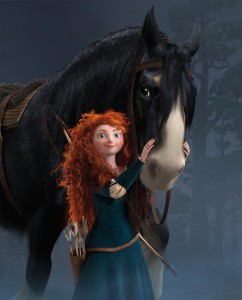 - This coming Tuesday, the Academy is screening Pixar’s Brave. I’ll certainly see it, and I’ve invited a number of people to the screening. I want to make sure it has a good audience for that first screening. I wish I were a bit more excited about it, but I’m not and I don’t know why. I hope to enjoy it and will report on my thoughts next week.
- This coming Tuesday, the Academy is screening Pixar’s Brave. I’ll certainly see it, and I’ve invited a number of people to the screening. I want to make sure it has a good audience for that first screening. I wish I were a bit more excited about it, but I’m not and I don’t know why. I hope to enjoy it and will report on my thoughts next week.
Up to now, I’ve pushed to see any animated feature the Academy screens. Last year I had to sit through two full weeks of animated features to be able to vote for the Oscar nominees. It was a lot to take in, especially since most of the films aren’t great. So it’s better to take them on one-at-a-time during the actual year in order to assure I won’t have to cram them all in. I wish the Academy had screened Madagascar 3 for us, so that won’t be one of those many features I’ll be forced to absorb at the last minute.
Oh wait. I just remembered that the Academy isn’t going to let the NY contingent vote to select the animated feature nominees. Too few people showed up at last year’s event and the cost of shipping the films and screening them was prohibitive – given those who’d shown up. I have to admit I was disappointed that too few took part, but that’s the game.
Consequently, that means I’ll probably only see Madagascar 3 on DVD. And I guess I won’t get to see this year’s Whiskers or Chico & Rita unless I actually go to a theater to see them – if they become available. Whiskers still hasn’t played in NY. I could have seen it if I went, this year, to Annecy, but I didn’t.
Let’s face it, the animation members don’t all have the opportunity of voting on their category. This means that a few people in LA will control who gets nominated next year. The unfortunate thing is that it doesn’t make for the best for the category. The larger the vote, the better would be the outcome. The members, themselves, in NY are the problem, but what can be done. Personally, I think they should probably get rid of the category. Pixar will put a billion dollars into publicity to make sure the few in LA pick their movie, and it’ll probably win. It may even deserve it. But, to me, too few are selecting the sample, and the politics aren’t easy to overcome.
Harvestworks
 Harvestsworks is hosting an animation art program by artists, Gregory Barsamian, Emily Hubley, George Griffin, Holly Daggers and Jeff Scher. This art show and screening at Harvestworks is curated by Phyllis Bulkin-Lehrer. The works all explore the use of digital production in creating traditional projection methods. Whether using New Media or keeping it at arms length.
Harvestsworks is hosting an animation art program by artists, Gregory Barsamian, Emily Hubley, George Griffin, Holly Daggers and Jeff Scher. This art show and screening at Harvestworks is curated by Phyllis Bulkin-Lehrer. The works all explore the use of digital production in creating traditional projection methods. Whether using New Media or keeping it at arms length.
The show opened in New York this past Thursday and will continue thru until June 28th.
Location:
Harvestworks – www.harvestworks.org
596 Broadway, #602 | New York, NY 10012 | Phone: 212-431-1130
Subway: F/M/D/B to Broadway/Lafayette, R to Prince, 6 to Bleecker Street
The installation is open 1 – 6 pm Tuesdays – Saturdays and is FREE
Storyboard Approach
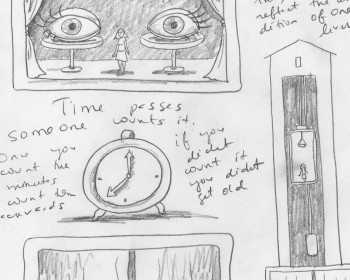 - There’s an interesting post up at Signe Baumane‘s site. She does a video post of how she does storyboards for her in-progress feature, Rocks In My Pockets. She also posts a short video by Bill Plympton which explains how he does storyboards and how he uses them. The two have very contrasting methods.
- There’s an interesting post up at Signe Baumane‘s site. She does a video post of how she does storyboards for her in-progress feature, Rocks In My Pockets. She also posts a short video by Bill Plympton which explains how he does storyboards and how he uses them. The two have very contrasting methods.
Bill is an ex comic strip artist. To me, his storyboards are more comic strip than storyboard. They move from dynamic pose to dynamic pose without logically following the language of film. It tends to make for some uncomfortable cuts within his films but helps them appeal to the cartoonists out there. (I don’t think there’s a Plympton film that doesn’t have a cut where he crosses the 180, making it very frustrating to watch for people like me.)
Signe is a writer, so she doesn’t do storyboards. Or so she says. She starts each scene by going to the script and selecting text to illustrate/animate. Though she doesn’t properly board these scenes, she does a bevy of thumbnails for them. Then she plows into the animation and does the work. The interesting thing, to me, is that Signe DOES follow all the rules of filmmaking. My guess is that she does this instinctively from a long history of watching and absorbing film.
Two different approaches and unexpected results.
Take a look at the videos; they’re short.
Commentary 09 Jun 2012 05:54 am
Snow White & Paul Williams
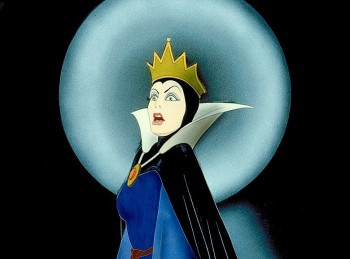 - We all know Snow White was the first animated feature. On Thursday I got to see the most recent version of the fairy tale, Snow White and the Huntsman. Times have changed, and animation is no longer animation. In reality, today, animation is a combination of live action combined with a digital puppetry. The purest form of these films, to me, is not the product of Pixar or Dreamworks; it’s these live action hybrids that overuse special effects, to the point where they’re no longer special. They’re just a bombardment of effects. Snow White and the Huntsman is a good example of one of these overeffected films.
- We all know Snow White was the first animated feature. On Thursday I got to see the most recent version of the fairy tale, Snow White and the Huntsman. Times have changed, and animation is no longer animation. In reality, today, animation is a combination of live action combined with a digital puppetry. The purest form of these films, to me, is not the product of Pixar or Dreamworks; it’s these live action hybrids that overuse special effects, to the point where they’re no longer special. They’re just a bombardment of effects. Snow White and the Huntsman is a good example of one of these overeffected films.
 Like the film, Mirror Mirror, another pathetic attempt to rework the same tale, this film stars a superstar actress as the Queen mother/witch. That means that the film is no longer Snow White, but it’s about Snow White’s mother. To boot they get some young “star” who isn’t up to the challenge to play “Snow White.” Kristen Stewart gets top billing over Charlize Theron, yet, in my opinion, she can’t walk in the shadow of Ms. Theron. She can’t act as well and she sure isn’t as beauiful as the Stepmother/Queen. What you really need in this role is a young Elizabeth Taylor, someone as stunningly beautiful as that. She has to be more attractive than Charlize Theron. That’s what it says in the script; it’s key to the story. Maybe my values are messed up; but I don’t see Kristen Stewart as anything more than ordinary looking, and I don’t call her aimless self-reflective movement anything close to acting.
Like the film, Mirror Mirror, another pathetic attempt to rework the same tale, this film stars a superstar actress as the Queen mother/witch. That means that the film is no longer Snow White, but it’s about Snow White’s mother. To boot they get some young “star” who isn’t up to the challenge to play “Snow White.” Kristen Stewart gets top billing over Charlize Theron, yet, in my opinion, she can’t walk in the shadow of Ms. Theron. She can’t act as well and she sure isn’t as beauiful as the Stepmother/Queen. What you really need in this role is a young Elizabeth Taylor, someone as stunningly beautiful as that. She has to be more attractive than Charlize Theron. That’s what it says in the script; it’s key to the story. Maybe my values are messed up; but I don’t see Kristen Stewart as anything more than ordinary looking, and I don’t call her aimless self-reflective movement anything close to acting.
For the first half hour of the film things move along like a traditional animated feature. Lots of beautiful composed and constructed sets and costumes and really special effects. It’s hard to tell the animation from the live action. Trees are moving of their own accord, costumes move, animals move in orthodox ways. It’s thoroughly engrossing. Then the film goes Celtic as they leave the castle on the chase/journey. Through the scary dark woods, past a village of women, into the realm of fairies where the seven dwarfs are a wonderful special effect. Great British and Irish acors like Ian McShane, Eddie Marsan, Bob Hoskins and Toby Jones are shrunk to look like dwarfs. The effect is totally believable, and the actors are wonderful.
 This is where the film tells us it’s an animated movie. There are two creatures literally ripped right out of Miyazaki’s Princess Mononoke. Scenes from that animated feature are reproduced exactly for this Snow White. It’s not even original enogh to create its own gods, it has to steal Miyazaki’s.
This is where the film tells us it’s an animated movie. There are two creatures literally ripped right out of Miyazaki’s Princess Mononoke. Scenes from that animated feature are reproduced exactly for this Snow White. It’s not even original enogh to create its own gods, it has to steal Miyazaki’s.
 Then there’s the journey back after a couple of fights. Then there’s the poison apple (well done, I might add) and eventually the first love’s kiss brings on the resuscitation of Snow White. The problem is, that isn’t the end. Now Snow White has to become Joan of Arc or is it (Henry V) to do battle with the evil Queen.
Then there’s the journey back after a couple of fights. Then there’s the poison apple (well done, I might add) and eventually the first love’s kiss brings on the resuscitation of Snow White. The problem is, that isn’t the end. Now Snow White has to become Joan of Arc or is it (Henry V) to do battle with the evil Queen.
They’ve taken the fairy tale and turned it on its ear, so that it really doesn’t have much significance anymore. Her name is “Snow White”, she’s supposed to be innocent! Love’s first kiss should be the end of the story. It’s just the introduction of the heroine, who earlier told us she could never kill anyone, who will lead us into battle. The film is ultimately just the means for a lot of effects. The one that gets a bit old is the transition of objects (birds, soldiers, anything on screen) into shiny shards of shale-like stone. Flecks of things go flying everywhere, over and over again. It works well the first three times but a dozen times later, we’ve seen it.
The film, at one point, really is onto something, but that gets lost and it certainly loses the message of the fairy tale.There’s something there until it’s no longer there. Too bad.
But it’s still miles north of The Avengers or some of the superhero films we’ve seen this summer. And it does have Charlize Theron. Onto a screening of Prometheus, this coming Monday, also with Charlize Theron. A different kind of animated feature. Personally, I wish it were a new Miyazaki film.
 - For many years, I was a big fan of songwriter/singer/actor, Paul Williams. I collected all of his albums back in the 70s and 80s and went to see him in concert a couple of times. I tolerated his acting in a lot of horrible movies (like the Smokey & the Bandit series) and tv shows (like Baretta, The Gong Show and The Love Boat) which almost mocked the seriousness of his music, and I still remained something of a fan.
- For many years, I was a big fan of songwriter/singer/actor, Paul Williams. I collected all of his albums back in the 70s and 80s and went to see him in concert a couple of times. I tolerated his acting in a lot of horrible movies (like the Smokey & the Bandit series) and tv shows (like Baretta, The Gong Show and The Love Boat) which almost mocked the seriousness of his music, and I still remained something of a fan.
In the past couple of weeks, I received an invitation to attend a new documentary called, Paul Williams:Still Alive, at a private screening and then to meet up with Mr. Williams at a post wine and cheese thing. Naturally enough, I jumped at the chance and went to this screening last Monday evening at the HBO screening room in town. The fear I had that this might be more like one of those bad 70s movies that Mr. Williams starred in was negated immediately when I’d read an interesting interview he did with the NY Times. It got me in the mood to see this film.
Surprisingly, the film started just about on time. It was introduced by its director, Stephen Kessler. His introduction was very short and led us right into the film. The theater was full, as a matter of fact this screening room has a second room attached which projects the film onto that second screen simultaneously. Both were full, and I’ve seen several reviews come out of this particular screening..
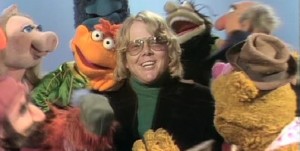 The film starts out about a fan (the director) who hounds a celebrity until he gets to interview him and then makes him the subject of his documentary. At first, it almost seems as though the film were more about Steve Kessler than about Paul Williams. But in the small moments with Mr. Williams, on film, you see that he is beginning to control the film, for the better sake of the movie. Right at the start, Willliams suggests that the film should not be one of those where the voice of the questioning film maker is cut out, so the ego of the “star” is hung out to dry. He pulls Mr. Kessler into the shot and tells him that the film has to be about the two of them.
The film starts out about a fan (the director) who hounds a celebrity until he gets to interview him and then makes him the subject of his documentary. At first, it almost seems as though the film were more about Steve Kessler than about Paul Williams. But in the small moments with Mr. Williams, on film, you see that he is beginning to control the film, for the better sake of the movie. Right at the start, Willliams suggests that the film should not be one of those where the voice of the questioning film maker is cut out, so the ego of the “star” is hung out to dry. He pulls Mr. Kessler into the shot and tells him that the film has to be about the two of them.
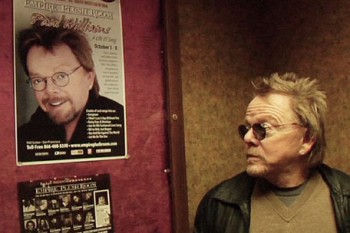 He then makes it clear when and if the camera should be running. He lightly cajoles Mr. Kessler into giving him, Mr. Williams, moments alone with his wife, and the film gets to be funny at the director’s expense. The film takes a very pleasant shape and finally comes solidly together during a concert tour of the Philippines, where Stephen Kessler is terrified that there are terrorists around every bend and their lives are in jeopardy. A bonding happens between the star and the director, and the film really takes hold. The intelligence of Paul Williams definitely comes through and shapes this documentary for Mr. Kessler, and the movie gives us a lot to care about. At almost every turn the treacly ideas of Mr. Kessler are often squelched by the good taste of Mr. Williams. At the point of the big climax, toward the end, Mr. Kessler proposes they sit down and watch some of the tv moments of the past for Mr.Williams. The idea being to watch Paul Williams squirm at some druggy moment cohosing the Merv Griffin Show. Finally, they do get to it, and Mr. Williams walks out on it. doing so shapes the climax and gives the film what it wants without any squirmy moments. It’s a good finale for the film, and gives Paul Williams all the dignity he deserves and gives the film the high point Stephen Kessler is searching for.
He then makes it clear when and if the camera should be running. He lightly cajoles Mr. Kessler into giving him, Mr. Williams, moments alone with his wife, and the film gets to be funny at the director’s expense. The film takes a very pleasant shape and finally comes solidly together during a concert tour of the Philippines, where Stephen Kessler is terrified that there are terrorists around every bend and their lives are in jeopardy. A bonding happens between the star and the director, and the film really takes hold. The intelligence of Paul Williams definitely comes through and shapes this documentary for Mr. Kessler, and the movie gives us a lot to care about. At almost every turn the treacly ideas of Mr. Kessler are often squelched by the good taste of Mr. Williams. At the point of the big climax, toward the end, Mr. Kessler proposes they sit down and watch some of the tv moments of the past for Mr.Williams. The idea being to watch Paul Williams squirm at some druggy moment cohosing the Merv Griffin Show. Finally, they do get to it, and Mr. Williams walks out on it. doing so shapes the climax and gives the film what it wants without any squirmy moments. It’s a good finale for the film, and gives Paul Williams all the dignity he deserves and gives the film the high point Stephen Kessler is searching for.
I also have to say that the editor, David Zieff, knew enough to follow the guide posts and let the film seem to fall together naturally. You know this doesn’t just happen, and it takes a good editor to make it work in a documentary such as this.
It’s a very good film, with a broad view of Mr. Williams’ career and a strong view of how his life has changed and ripened, post-rehabilitation. It just about concludes with Mr. Williams becoming ASCAP’s president with a mission to help protect the music rights of a lot of younger composers.
After the screening, they did have that wine and cheese event, and I recognized several people who I talked with, and some minor celebrities (Richard Kind) who I didn’t talk with. As I was leaving I passed Paul Williams and director Stephen Kessler, and I was tempted to say something. But I didn’t. The film answered any question I’d had, and I am too shy to just nose in on a celebrity and take up their time. Though I suppose that’s the purpose of such an event.
Actually, the film didn’t answer one question I had. Back in the very early 70s, I wrote to Paul Williams (care of his record company) seeking rights to a song he recorded called Lucky Old Sun. I thought it’d make a great animated short and wanted to find out what to do to get the rights. Of course, I never heard back from him and assume that he never got my letter. After all, it probably felt more like a fan letter than anything else. Even I wasn’t naive enough to believe it’d get to the right channels.
Commentary 02 Jun 2012 06:30 am
Processing Onward
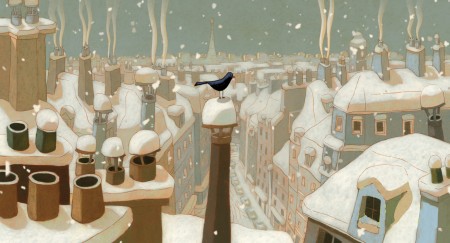
A Cat In Paris
- A Cat In Paris opened officially in New York, yesterday. You may remember that this film, a smidge longer than one hour, was one of five nominees this past year for the Best Animated Feature Oscar. It is a French film animated in 2D and is a satisfying film. It is far from great but also far from bad.
It was a year of films like Cars 2, the sequel to Pixar’s Cars, which had a budget north of $200 million, or Kung Fu Panda 2 the sequel to Dreamworks’ Kung Fu Panda with a budget of $150 million or Puss In Boots, the spin-off of a character from Dreamworks’ Shrek 2 with a budget of $130 million. Two of these three were also nominated for the Oscar (a hint – not the Pixar film.)
This film, The Cat In Paris, received a mix of reviews in NY. The NYTimes‘ A.O.Scott called it, ” . . . a refreshing reminder, at a time of large-scale, highly polished cinematic spectacle, of the essential, elemental sources of movie-watching pleasure.” There was no doubt that Mr. Scott was charmed with the film.
Lou Leminick of The NYPost gave it two stars and wrote, “. . . it seems slight and unremarkable, especially compared to two other wonderful French-language nominees in this category in recent years, “The Triplets of Belleville’’ and “The Illusionist.’’
Michael Atkinson of The Village Voice wrote, “A sketchy trifle of French animation grabbing time in theaters thanks to its recent Oscar nomination . . . seeks shelf space beside Sylvain Chomet’s deft and rapturous hand-drawn cartoons (The Triplets of Belleville, The Illusionist), and the required self-conscious Frenchiness is spot-on.”
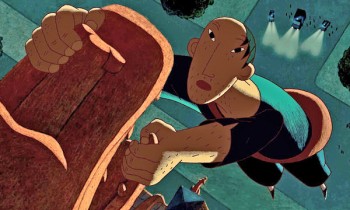 I saw the film last year toward the end of a two week screening of 18 animated features contending for the Oscar nomination. By the time I saw it, I’d been filled with horrendous cgi films like Alvin and the Chipmunks and Puss In Boots and, god help us, Hoodwinked 2. The Cat In Paris came over as the height of sophistication and whimsy. I’m sure I need to see the film again to properly judge it, but I do remember it as nicely designed in a European cartoon style, with a very nice music track and serviceable animation.
I saw the film last year toward the end of a two week screening of 18 animated features contending for the Oscar nomination. By the time I saw it, I’d been filled with horrendous cgi films like Alvin and the Chipmunks and Puss In Boots and, god help us, Hoodwinked 2. The Cat In Paris came over as the height of sophistication and whimsy. I’m sure I need to see the film again to properly judge it, but I do remember it as nicely designed in a European cartoon style, with a very nice music track and serviceable animation.
I enjoyed the movie and am certain I’d feel the same on viewing it again. My thoughts were closer to siding with Mr. Scott’s review in the Times. It wasn’t great; it wasn’t bad. It was a wholly entertaining hour.
- Tom Stathes is one of those incredibly dedicated people who’ve made animation history their life. As a result, the work he’s done, particularly for the silent animated film, has become an enormous contribution to the medium, especially given the internet’s total lack of interest in the subject. This is a rare focus that is wholeheartedly needed for the preservation of that part of the form.
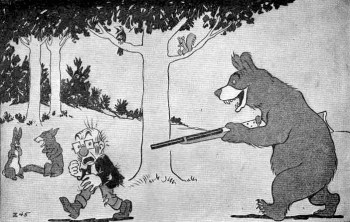 His establishment of the Bray Project has given attention to the studio that was certainly the first very large animation studio in the world with an enormous product and a strong control over the medium of the day. Established in 1911, the Bray Studio produced generally poor cartoons, (most silent cartoons of this period were poor films) but they allowed many pioneers to begin their careers on the right step. From Walter Lantz to Max Fleischer to Paul Terry, many of the giants sat in this studio first.
His establishment of the Bray Project has given attention to the studio that was certainly the first very large animation studio in the world with an enormous product and a strong control over the medium of the day. Established in 1911, the Bray Studio produced generally poor cartoons, (most silent cartoons of this period were poor films) but they allowed many pioneers to begin their careers on the right step. From Walter Lantz to Max Fleischer to Paul Terry, many of the giants sat in this studio first.
Mr. Stathes recently sent out this email note announcing that the Bray Project is now one year old. I thought it important to post the email and give a little nod to Tom and all the great work he’s doing.
- Dearest Friends and Colleagues,
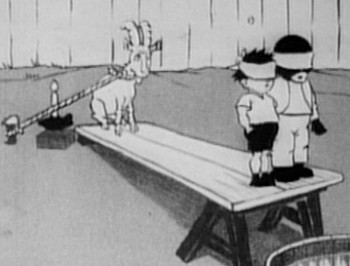 It is now one year since the Bray Animation Project website launched. And it’s been a great year at that!
It is now one year since the Bray Animation Project website launched. And it’s been a great year at that!
Many incredibly exciting rare film finds have been made since the site’s debut and I’ve shared a little bit of information about that in a special blog post here.
The Bray site will see some fixes, updates, and further add-ons in the near future. More excitingly, though, please keep posted for some very important announcements from yours truly to follow in the next few weeks. I once again invite interested parties to discuss research or post questions at the site’s discussion board.
Thank you all for taking an interest in this project or for being a supportive element in my film history and archiving endeavors in general. I wouldn’t be able to achieve much of what I have without the help of many of you.
Cordially,
Tom Stathes
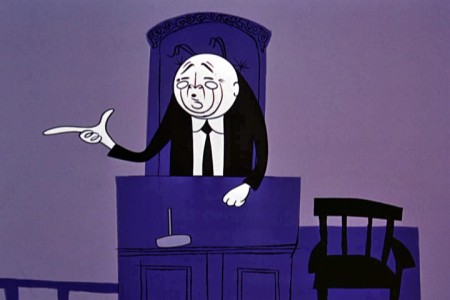 - Thad Komorowski is someone else who continually surprises me with the depth of his knowledge about animation history. I shouldn’t be taken aback whenever I go to his blog and column. The reportage is always first rate, thorough, and the subject is often something I hadn’t even thought about. Yet, a lot of research and work has gone into those columns, and I can only admire them and bookmark their pages so that I can come back and reread it another time or two.
- Thad Komorowski is someone else who continually surprises me with the depth of his knowledge about animation history. I shouldn’t be taken aback whenever I go to his blog and column. The reportage is always first rate, thorough, and the subject is often something I hadn’t even thought about. Yet, a lot of research and work has gone into those columns, and I can only admire them and bookmark their pages so that I can come back and reread it another time or two.
Often, Thad talks about the process rather than the ideology behind the animation. This week, for example, he wrote about the Technicolor backlog once WWII had ended. Studios working in IB Tech weren’t able to get their negatives developed or their print orders met. Waiting years to get their films to market had to have hurt the market, especially given the break up of theater monopolies by the studios. Some of the smaller studios had to turn to Cinecolor to get even second rate prints made. All to go to market.
Thad also gives us an example of a Columbia short that was printed on Cinecolor. We can see how lacking it is in its color quality, and we can also see how dreadful the cartoon is in the quality of its art. It’s one of those shorts you know is so bad you can’t understand why you’re continuing to watch it, yet it’s THAT bad that you can’t stop watching it. The Cinecolor is only the icing on the cake.
And speaking of process just read the posts The WB Production Number Project or MGM Cartoon Filmography by Production Number. These are all about accounting, but since it’s part of the principal production of those glorious Hollywood shorts, it’s information that should be relayed. And I have to say, in my fifty odd years of reading about animation and its history, this is the first time any of these subjecs has come up. It’s not something I need to know, but it’s something I’m astonished to realize I didn’t know. And, believe it or not, this is information I want to have.
As Thad’s work matures, so too his reviews. His lengthy review of Adam Abraham‘s book, When Magoo Flew, is a first rate look at Abraham’s work. It fairly points out the shortcomings of the book, but also tells how important this book is given the lack of other material available on the subject of UPA’s birth. More importantly, Thad has a separate blog post about the Jolly Frolics shorts.
Like most good reviews, there are treasures built into them. Thad appropriately assays Bobe Cannon‘s career in a short and on-target side note. Since Cannon directed many of the most famous UPA cartoons, this is entirely necessary.
- Bobe Cannon was one of animation’s most puzzling treasures. He came up through the ranks at Schlesinger’s and is said to have been critically involved with the concept of smear animation with Chuck Jones. He ultimately abandoned all of what was fun in his own animation in the cartoons he directed at UPA. There are still traces of it in “The Miner’s Daughter” and “Georgie and the Dragon,” and Cannon and Paul Julian (one of the studio’s real unsung heroes) also helmed “Wonder Gloves,” a vastly underrated cartoon with simple but highly pleasing design and animation.
I don’t always agree with Thad, but he gets me to read his evaluation and think about what he’s had to say. Something any good historian or writer would do. I enjoy attending to his blog and appreciate it every time there’s something new. If you’re as much a sucker for animation history as I am, you’ll want to do the same. What About Thad.
Commentary 26 May 2012 05:05 am
Stuff
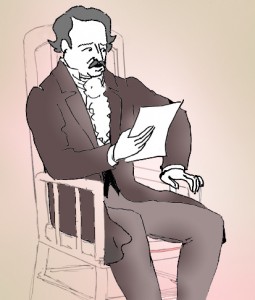 - Finally, the Indiegogo campaign is complete, and it was a total success.
- Finally, the Indiegogo campaign is complete, and it was a total success.
Thank you all. The amount shown on PayPal doesn’t reach the $13,000 goal requested, just $12,225. But several people had difficulty with PayPal and asked to just send me the money directly. With that additional $1450, we’ve definitely reached and passed the goal, and I couldn’t be happier. $13,675.
I’d like to thank those people who opened up their blogs to make mention of the campaign. Michael Barrier and Mark Mayerson had a direct effect on the moneys contributed. I can track several thousand dollars directly to their promotions. I’d like to thank them for the unbridled support they both gave. The same is true of several others, most notably Bill Benzon and Steve MacQuignon. There were certainly others I wasn’t aware of, and I’d like to thank those people as well. Including all those who listed it on Facebook. Every mention helped. Hillary was right; it does take a village. Thank you enormously for the reinforcement.
I’ve been working on the storyboard for the sequence I plan to animate and have been moving much-too-slowly. I’ve been reworking every drawing endlessly, and will have to get to just roughing them out. As we all know, the finish of the storyboard drawings is basically irrelevant to the completed movie. Getting the emotion and the power of the sequence across is much more vital. That’ll be happening, and the project will be moving forward immediately.
We have been negotiating with a cable TV company about selling the US rights to the film, and I expect to have a deal in the next couple of weeks. This will give us the traction to raise the rest of the funds for the feature. We have a sales agent in England who will sell the film (with the help of the trailer I’m making, thanks to your support) outside of the U.S. to complete the budget.
I’m at the starting line just waiting for that gun to go off, and I definitely heard a pop!
A Cat In Paris
- A Cat in Paris is opening in NYC for all you who missed it in its recent run for the Oscar. It’s an exceptionally good animated feature distributed by GKids. Directed by Jean-Loup Felicioli and Alain Gagnol it tells the story of a pet cat that leads a double life. By day he lives with Zoe, whose mother is a detective in the Parisian police force. But at night he sneaks about the rooftops of Paris working with Nico – a cat burglar, whose fluid movements are poetry in motion – as he evades captors and goes from rooftop to rooftop across the Parisian skyline.
It’s a delightful film with few words of dialogue and a beautiful sense of style.
Fri Jun 1 ANGELIKA FILM CENTER
10:55 12:25 1:55 3:25 4:55 6:25
Sat Jun 2 ANGELIKA FILM CENTER
10:55 12:25 1:55 3:25 4:55 6:25
Sun Jun 3 ANGELIKA FILM CENTER
10:55 12:25 1:55 3:25 4:55 6:25
Buy tickets in advance here.
Fantastic Mr. Anderson
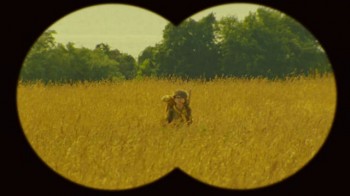 - It wasn’t too long ago that I was raving over Wes Anderson‘s adaptation of The Fantastic Mr. Fox, Raold Dahl‘s novel, made into film using animated puppets. I saw Anderson’s most recent film, Moonrise Kingdom this week. To my taste, it’s a wonderful film, despite the fact that it’s not animated. Like all of his films, it’s so obvious that Mr. Anderson made it. The compositions are offset, the search for a real live father is always part of the story, and the set design is particular; it could only be he who directed the movie. I also find that I tend to smile throughout his films. That’s certainly true of this movie. It went on a bit long for me, but that’s ok. I’ll still go to see it again.
- It wasn’t too long ago that I was raving over Wes Anderson‘s adaptation of The Fantastic Mr. Fox, Raold Dahl‘s novel, made into film using animated puppets. I saw Anderson’s most recent film, Moonrise Kingdom this week. To my taste, it’s a wonderful film, despite the fact that it’s not animated. Like all of his films, it’s so obvious that Mr. Anderson made it. The compositions are offset, the search for a real live father is always part of the story, and the set design is particular; it could only be he who directed the movie. I also find that I tend to smile throughout his films. That’s certainly true of this movie. It went on a bit long for me, but that’s ok. I’ll still go to see it again.
Alexandre Desplat is definitely writing the best scores for films these days, though Tom Newman is no slouch either.
Bklyn Film Festival
- While many animators will be in Annecy at the opening of June, there’s an alternative for those of us stuck in New York. The Brooklyn International Film Festival will run from Friday June 1st through Sunday June 10th. Their program includes many animated short films. I suggest you go to their site to look for more information about any of these films as well as screening times. These are the titles and list of directors that will be screened:
2012 ANIMATION FILM LINEUP
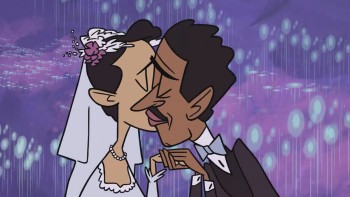 ALWAYS A FAMILY Dir: The Rauch Brothers, United States, 4 min, 2011
ALWAYS A FAMILY Dir: The Rauch Brothers, United States, 4 min, 2011ANIMEDITATION Dir: Jonathan Rosen, United States, 3 min, 2011
BOOBATARY Dir: Leah Shore, United States, 2 min, 2010
BOX, THE Dir: Dadomani Studio, Italy, 3 min, 2012
CITY OF GOOD PEOPLE Dir: Hur Bum-wook, Korea, 16 min, 2011
COUNTDOWN Dir: Celine Desrumaux, England, 4 min, 2011
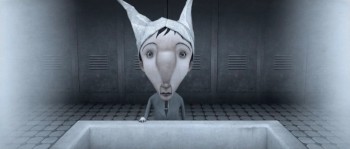 EDMOND WAS A DONKEY Dir: Franck Dion, France, 15 min, 2012
EDMOND WAS A DONKEY Dir: Franck Dion, France, 15 min, 2012GALLERY Dir: Robert Proch, Poland, 5 min, 2010
GOLDEN EARS Dir: Jonathan Rosen, United States, 5 min, 2011
HUNTER, THE Dir: Marieka Walsh, Australia, 7 min, 2011
INNER CITY Dir: Alain Fournier, Canada, 9 min, 2011
KING CREOSOTE & JON HOPKINS – BUBBLE Dir: Elliot Dear, England, 5 min, 2011
LADDER, THE Dir: Emily Wormley, United States, 4 min, 2011
LAST BELLE, THE Dir: Neil Boyle, England, 19 min, 2011
LIGHT THAT DIED IN MY ARMS, THE Dir: Alan Foreman, United States, 2 min, 2012
MAKING OF LONGBIRD, THE Dir: Will Anderson, Scotland, 15 min, 2011
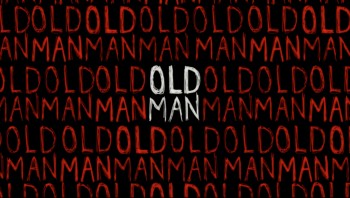 OLD MAN Dir: Leah Shore, United States, 6 min, 2012
OLD MAN Dir: Leah Shore, United States, 6 min, 2012
OLD MAN AND THE OLD WOMAN, THE Dir: Basia Goszczynska, United States, 8 min, 2011
SID THE KILLER Dir: Harry Teitelman, United States, 5 min, 2011
STOPOVER Dir: Neil Stubbings, Switzerland, 4 min, 2011
TULIPOMANIA: RUMBLE THUD Dir: Cheryl Gelover & Tom Murray, United States, 3 min, 2011
WE, THE MASSES Dir: Eoghan Kidney, Ireland, 14 min, 2011
WHO LASTS LONGER Dir: Gregorio Muro, Spain, 12 min, 2011
WOLF DOG TALES Dir: Bernadine Santistevan, United States, 6 min, 2012
Arjun – The Warrior Prince
- Yesterday an Indian animated feature opened in NYC. It was reviewed in the NYTimes by Rachel Saltz in a relatively short review.
An Animated Mahabharata, it opened in New York, Los Angeles, San Francisco, Chicago, Dallas and Houston. Who knows how long it will play. The stills for the film are certainly provocative.
For now it’s at: AMC Loews Village 7
(I found it a bit difficult to actually find out where it’s playing.)
10:45am, 1:00pm, 3:30pm, 5:45pm, 8:05pm, 10:30pm
This film is from the studio, UTV, an Indian communications conglomerate, that was taken over by Disney; they are billed as a “Co-presenter.”
According to the NYPost, “. . . the title character vaguely resembles Disney’s Tarzan, but nobody is going to mistake the less-than-state-of-the-art, computer-game-style 2-D animation for the work of” . . . Disney, much less its Pixar subsidiary.
Traditional Animation
- James Nethery posted a longish interview with me on his site, Traditional Animation. You might want to take some time floating around the site while you’re there; you’ll find a lot of very entertaining material there (despite the interview. I can get chatty at times!)
I’ve added this site to my blogroll.
Commentary &Daily post &SpornFilms 20 May 2012 06:26 am
Poe Props
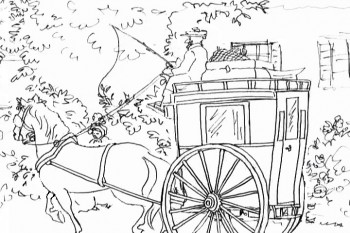 - There’s a certain difficulty in making a film about 1820-1850 as opposed to making it about 1850-1880. Things, in the New World, were being invented and didn’t look like any other eras. I suppose this is true about any era; there are always complications. New York City, for example, changed drastically in 1888, February 1888. Before that date the sky in the City was a mass of wires. One could barely see the sky for all the wires that were strung across the terrain. However, in February of 1888, there was a violent snow storm that knocked down all the wires, and that was the excuse the City enjoyed as they buried the wires underground. So after February of 1888, the sky was wide open, and the City had a major face lift. Photographs of the City from that period are remarkable.
- There’s a certain difficulty in making a film about 1820-1850 as opposed to making it about 1850-1880. Things, in the New World, were being invented and didn’t look like any other eras. I suppose this is true about any era; there are always complications. New York City, for example, changed drastically in 1888, February 1888. Before that date the sky in the City was a mass of wires. One could barely see the sky for all the wires that were strung across the terrain. However, in February of 1888, there was a violent snow storm that knocked down all the wires, and that was the excuse the City enjoyed as they buried the wires underground. So after February of 1888, the sky was wide open, and the City had a major face lift. Photographs of the City from that period are remarkable.
Well, the same was true of the props of the early part of the 19th Century. The first railroad train, for example, was engineered by Peter Cooper in 1829 and stretched from Baltimore to the village of Ellicott’s Mills thirteen miles west. The train, called the Tom Thumb, was modeled after a British locomotive. Since Edgar Allan Poe did a lot of traveling throughout his life, it was obvious to recreate such a vehicle and have our hero ride the rail – with an imagined orangutan, an animal that had just been discovered, and was seen to be the “missing link” they were searching for. Poe, of course, was aware of this news story, and incorporated an orangutan in the story, Murder in the Rue Morgue.
We did have to do some specific research for the train. We didn’t want something as early as the “Tom Thumb,” but we did want something a few years later.
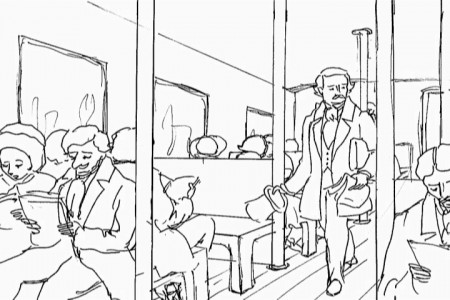
Boarding the train.
It was also as likely for Poe to have traveled from New York to Maryland via many different other means of transportation. No doubt, part of the trip would be made via some short-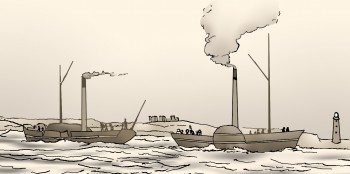 distanced local ferry. After all, it would have been faster to move over a body of water than over the land. In his lifetime, Poe lived in New York, Philadelphia, Baltimore, and Boston. To get from one place to another meant some significant travel as well as time and money. Edgar, Muddy (his Aunt/Mother-in-Law) and Virginia (his young wife) had to negotiate meticulous plans to travel. He wanted the least expensive route and the shortest travel time. Carriage, rail, horseback and ferry were the only real options open to them.
distanced local ferry. After all, it would have been faster to move over a body of water than over the land. In his lifetime, Poe lived in New York, Philadelphia, Baltimore, and Boston. To get from one place to another meant some significant travel as well as time and money. Edgar, Muddy (his Aunt/Mother-in-Law) and Virginia (his young wife) had to negotiate meticulous plans to travel. He wanted the least expensive route and the shortest travel time. Carriage, rail, horseback and ferry were the only real options open to them.

We also have a song in the show. Virginia was a singer. She died of complications after a blood vessel ruptured in her throat. There are songs that Edgar Allan Poe wrote for Virginia 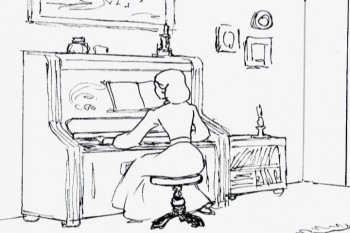 and his sister, Rosalie. In the film, Virginia sings one of those songs. Obviously, we had to know what kind of piano they would have had in their home – their poor and little home.
and his sister, Rosalie. In the film, Virginia sings one of those songs. Obviously, we had to know what kind of piano they would have had in their home – their poor and little home.
Pictured above is Rosalie’s piano gifted to Poe Cottage after her death in 1865. We imagined Virginia’s piano to be slightly different.
The good fortune that we do have is that Poe Cottage still stands as a tiny museum in the Fordham section of the Bronx. I grew up only a mile or two away from it, and I’ve passed it hundreds of times. Interestingly, I still haven’t visited it, though I certainly will before the film actually starts production. In fact, I expect to have a studio trip so we can all take it in together.

Poe Cottage in the Bronx.
There’s also the more elaborate Poe House down in Baltimore. Many artifacts decorate the house, and many of these were in Poe’s possession.
See Poestory.net.
See our Facebook page.
Check out our Indiegogo page and share it with friends of friends.
Commentary &Daily post 19 May 2012 06:26 am
Going to the Movies
- We’ve currently been working hard to raise a little money to finance completion of a sampler of our proposed animated feature, POE. This is the biography of Edgar Allan Poe, and it’s a project that I’ve been working closely with for the past five or more years. A lot of research, writing, drawing, planning, boarding and – the hardest and most fun part – thinking about the shape of the film has been ongoing. It’s been a lot of work, and we haven’t really started yet. This has made me think often enough about the Big Picture – the shape of things to come.
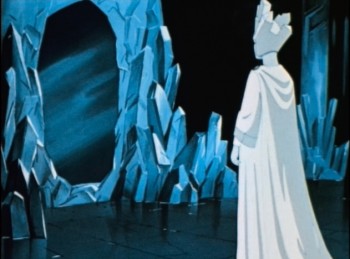 When I was a kid, I used to wait with baited breath for any Disney animated feature. Actually, I should say ANY animated feature. The theatrical release of The Snow Queen or Mr. Magoo’s Thousand & One Arabian Nights kept my juices flowing almost as much as did Lady and the Tramp or One Hundred and One Dalmatians. All of those films came off as “Special” and they stayed within my head. I tried to imitate them as a child filmmaker with my 8mm animated films, always producing 15-30 secs of my own version of these films before ultimately quitting on most of them.
When I was a kid, I used to wait with baited breath for any Disney animated feature. Actually, I should say ANY animated feature. The theatrical release of The Snow Queen or Mr. Magoo’s Thousand & One Arabian Nights kept my juices flowing almost as much as did Lady and the Tramp or One Hundred and One Dalmatians. All of those films came off as “Special” and they stayed within my head. I tried to imitate them as a child filmmaker with my 8mm animated films, always producing 15-30 secs of my own version of these films before ultimately quitting on most of them.
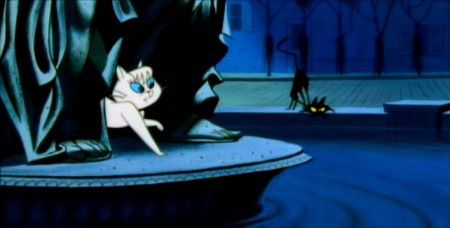
Gay Purr-ee
Then, in the ’70s, things really started to change. Animated features started to come at us fast and furious. Fritz the Cat, Secret of Nimh, Heavy Traffic, Rockadoodle, American Rabbit, The Adventures of Mark Twain, and too many others to mention. I stopped imitating the work; then I stopped going to the films. I still haven’t seen Treasure Planet. But I did see The Iron Giant, Balto and The Triplettes of Belleville, all of which might not have been made except for the glut of animation as the studios tried to cash in.
 Eventually, we moved to the current era with all those cgi movies. I have to admit that I’m not sure I see anything “Special” about The Tale of Despereaux or Despicable Me. Monster House was a mess, and the same for The Lorax, Arthur’s Christmas, Cars 2, or even Up and Finding Nemo, Bolt or Chicken Little, nevermind Dinosaurs. None of these are memorably important to me. Maybe The Brave will be. At the moment, who knows. It all rolls past so quickly and with very little value.
Eventually, we moved to the current era with all those cgi movies. I have to admit that I’m not sure I see anything “Special” about The Tale of Despereaux or Despicable Me. Monster House was a mess, and the same for The Lorax, Arthur’s Christmas, Cars 2, or even Up and Finding Nemo, Bolt or Chicken Little, nevermind Dinosaurs. None of these are memorably important to me. Maybe The Brave will be. At the moment, who knows. It all rolls past so quickly and with very little value.

Grendel Grendel Grendel/font>
I loved Spirited Away. Persepolis came and went as black and white as it actually was. I was completely rapt with Ponyo, and the animation in Arietty was something I wanted to see again. But the film was gone before I really had the chance. Sure I can get the DVD, but it’s not the same. I want the theatrical experience. The Illusionist, a favored film, was received with such a lack of enthusiasm, despite an Oscar nomination, that I was sharply disappointed.
I could keep going, but I think you may have gotten the point. There are just a lot of films, and nothing feels special anymore. They come, go, and are forgotten.
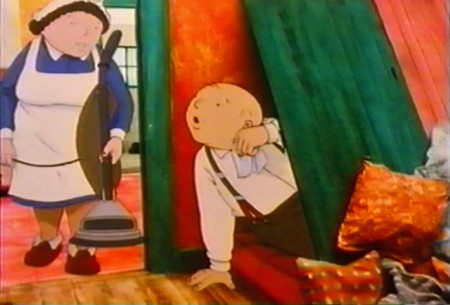
Where the Wind Blows
So now I’m about to do POE. What a lot of work, and I have to wonder how quickly it’ll be off the shelves. I haven’t even started making the movie and already I’m mourning its disappearance from theaters. Bill Plympton works his butt off to make his features, and he doesn’t even get a proper distribution. How does that feel, I wonder. I’m not sure how I’d take it.
But then, I suppose this is the lament for all movies, in the big picture. Only when a film rises above others will it be cherished. I may be in the minority, but I do cherish The Illusionist. I do remember the animation, and the filmmaking choices; the complex and delicate story. Circumstances aren’t right for it, but it does have its supporters. I can only hope for the same for a film I make and hope it sits at a theater for more than a weekend. However, I do have to wonder about the job I do and the disposability of it.
I suppose in some ways I’m reminded of theater. Those people put all their energy into a show that takes very hard work, indeed. Then they put on their show, and it’s gone. Only the few hundred in the live theater have seen it and will remember it. If it’s great, it will become legend; if it’s horrible it will become a different kind of legend. The original Follies or Carrie. If it’s mediocre, it doesn’t even become memorable.
What an odd business we’re in.
__________________________
Animation &Commentary &Hubley &Models &repeated posts 17 May 2012 07:17 am
Hub Eyes – repost
Here’s a post I wrote in 2009 that I still think is valuable, so I’m going to put it up again.
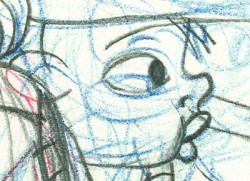 - It was 1973, and I was happily – I can’t tell you how happily – ensconced in the Hubley Studio working on Letterman, a new series for an upcoming CTW show, The Electric Company.
- It was 1973, and I was happily – I can’t tell you how happily – ensconced in the Hubley Studio working on Letterman, a new series for an upcoming CTW show, The Electric Company.
It was my first animation job. I inked it all (directly from animator roughs), I assisted & inbetweened it all, and I animated odd scenes including all the title sequences. I was a novice, and I was doing it all. Excited and happy is all I can remember.
I was alone one morning in the small room wherein I worked. I made a habit of getting into work before anyone and leaving after everyone. I wanted to make sure I was indispensible.
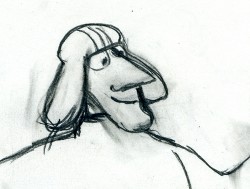 A month into the gig, and I think I’d only spoken with my hero, John, about a half dozen times. I was rushing through one of the Johnny Gent “Spellbinder” sequences. I inked all of his scenes, then inbetweened the drawings in ink. No time to work in pencil for this schedule. Johnny was completely off character, in a very old fashioned way, and I had to rework them all closer to the models – in ink. The schedule just gave me no time to be proud of what was happening. (A year or so later I apologized to Johnny for what I did to his artwork. I was so inexperienced and had such a dominant role in how the final art looked in that series.)
A month into the gig, and I think I’d only spoken with my hero, John, about a half dozen times. I was rushing through one of the Johnny Gent “Spellbinder” sequences. I inked all of his scenes, then inbetweened the drawings in ink. No time to work in pencil for this schedule. Johnny was completely off character, in a very old fashioned way, and I had to rework them all closer to the models – in ink. The schedule just gave me no time to be proud of what was happening. (A year or so later I apologized to Johnny for what I did to his artwork. I was so inexperienced and had such a dominant role in how the final art looked in that series.)
John Hubley ran in to give me something and made a quick comment about the character I’d been drawing. He said it was a “Paramount eye.” I looked at the drawing, then at him. Then John drew on a small piece of paper a “Disney eye,” then a “Terrytoon eye.” He laughed aloud and told me to try to “square off” the eyes a bit. Then he ran out.
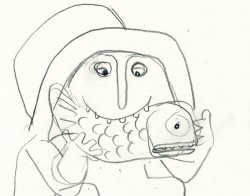 I learned a lot in a very short time. I watched eyes that day and probably all that week. I ran Hubley films at lunchtime (I’d made it a habit to project their films in the kitchen during many of the lunch breaks. The entire group working there enjoyed these sessions) and watched the eyes. I talked with Tissa David about eyes in one of our evening tutorials – she was trying to teach me how to inbetween properly.
I learned a lot in a very short time. I watched eyes that day and probably all that week. I ran Hubley films at lunchtime (I’d made it a habit to project their films in the kitchen during many of the lunch breaks. The entire group working there enjoyed these sessions) and watched the eyes. I talked with Tissa David about eyes in one of our evening tutorials – she was trying to teach me how to inbetween properly.
I was reminded of this moment when Chuck Rekow commented on the Moonbird Walk posted weeks ago. “The shape of the eyes on the boys is a real departure from almost anything in the cartoon world —even 50′s era. It’s closer to real life, and reminds me of the graphic style of Ben Shahn. It lends the film an aura of “seriousness”, even though it’s a cute film about two boys and an imaginary bird. Obviously, the pre-recorded sound is a major deal, but this gem is loaded with touches of inventive detail.”
How right he is, and I love being reminded of it.
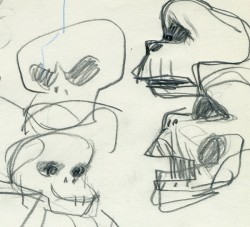 The eyes are the direct route to the soul of a person and, consequently, an animated character as well.
The eyes are the direct route to the soul of a person and, consequently, an animated character as well.
After working for the Hubley studio, for a short bit, I worked for Phil Kimmelman and Associates. This was a hardy commercial studio doing tight designer-based animation. Rowland Wilson was doing a lot of their design work, and the animation clean-up was tight. Animators Jack Schnerk, Sal Faillace and Dante Barbetta did a lot of the work the few months I was there. Jack Schnerk was also animating for Hubley, so I knew his very complicated-to-clean-up style. I worked primarily as an inbetweener and learned some hard and tight lessons while there.
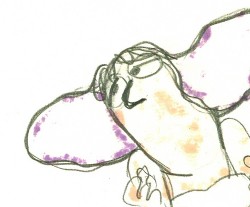 After the very loose work I’d been doing for the Hubley films, it was not only difficult for me, but good to keep me towing the proper line. I wanted to learn animation, and all of it was important.
After the very loose work I’d been doing for the Hubley films, it was not only difficult for me, but good to keep me towing the proper line. I wanted to learn animation, and all of it was important.
Here, too, an empahsis was on the eyes. No Disney eyes, no Hubley eyes, either. But now I was just concerned with keeping those lines tight tight tight. No shimmer on the eyeballs. After all, I was told, people stared into the characters’ eyes, and any flaws in the animation would show up first in those eyes.
I worked for PK&A for about three or four months. I’d also worked for Tubby the Tuba at NY Institute of Technology under Johnny Gentilella, where we got somewhat close and I was able to discuss all sorts of animation problems with him. That was the only redeeming element, everything else about that studio was wretched. My displeasure ultimately led to my leaving as soon as I could.
Eventually, I was back at the Hubley studio helping to finish up the short Cockaboody.
The tightening of my inbetwees only brought positives to what I could now do for John Hubley’s studio’s animation.
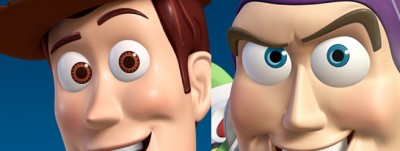 To this day, I still watch eyes closely. For some reason, the tighter the linework, the closer I watch the assistant’s work. The looser the line, the more I watch the design. I prefer watching the design. Often it means eyes that can be easily labelled: Disney, Paramount, or Terrytoons. I suppose today, you’d say: Pixar, Dreamworks or Blue Sky. (And believe me, you can see those differences even in cg.)
To this day, I still watch eyes closely. For some reason, the tighter the linework, the closer I watch the assistant’s work. The looser the line, the more I watch the design. I prefer watching the design. Often it means eyes that can be easily labelled: Disney, Paramount, or Terrytoons. I suppose today, you’d say: Pixar, Dreamworks or Blue Sky. (And believe me, you can see those differences even in cg.)
The images above are from the following films:
Commentary &SpornFilms 13 May 2012 07:12 am
A letter from Mrs. Gove Nichols
- We’re coming down the home stretch for our Indiegogo campaign to raise money for a sampler of the work from POE, the animated feature I’m trying to put together. It’s going wonderfully, and I hope we’ll be able to raise the money in these next two weeks. This has all given me a new lease on life in the project, and I expect it’ll help kick things off. One positive thing has been my writing these Sunday pieces about Edgar. I enjoy doing it.
This week, I’d like to write about a little sidebar note from the ever-revising script. A letter from a Mrs. Gove Nichols, an acquaintance of the Poes, telling about her trip to their final home in the Bronx.
.
 - One of the features of the film we’re doing about Edgar Allan Poe is that it provides us with the opportunity of including a number of letters from acquaintances of the little Poe family. One I particularly enjoy is this letter from Mrs. Gove Nichols. In it she tells of the arduous journey to reach the family in the Fordham section of the Bronx. It took several hours for the trip from midtown NY (and would take about 30 mins. today by subway.)
- One of the features of the film we’re doing about Edgar Allan Poe is that it provides us with the opportunity of including a number of letters from acquaintances of the little Poe family. One I particularly enjoy is this letter from Mrs. Gove Nichols. In it she tells of the arduous journey to reach the family in the Fordham section of the Bronx. It took several hours for the trip from midtown NY (and would take about 30 mins. today by subway.)
Here are several short excerpts from that letter:
- We found him, and his wife, and his wife’s mother who was his aunt living in a little cottage at the top of a hill.
The house had three rooms – a kitchen, a sitting room, and a bed chamber over the sitting-room. There was a piazza in front of the house that was a lovely place to sit in the summer, with the shade of cherry-trees before it.
On the occasion of my first visit, the poet had somehow caught a full-grown bob-o-link. He had put him in a cage, which he had hung on a nail driven into the trunk of a cherry-tree….
The cottage had an air of gentility that must have been lent to it by the presence of its inmates. So neat, so poor, so unfurnished, and yet so charming a dwelling I never saw. The floor of the kitchen was white as wheaten flour. A table, a chair, and a little stove it contained seemed to furnish it completely.
Later it continues:
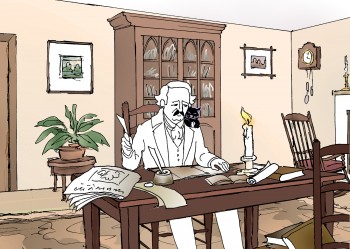 He was at this time greatly depressed. Their extreme poverty, the sickness of his wife, and his own inability to write sufficiently accounted for this. We spent half an hour in the house, when some more company came, which included ladies, and then we all went to walk.
He was at this time greatly depressed. Their extreme poverty, the sickness of his wife, and his own inability to write sufficiently accounted for this. We spent half an hour in the house, when some more company came, which included ladies, and then we all went to walk.
. . . someone proposed a game at leaping. I think it must have been Poe, as he was expert in the exercise. Two or three gentlemen agreed to leap with him, and though one of them was tall and had been a hunter in times past, Poe still distanced them all. But alas! his gaiters, long worn and carefully kept, were both burst in the grand leap that made him victor. … I was certain he had no other shoes, boots, or gaiters. Who amongst us could offer him money to buy a new pair?
Eventually, Poe’s mother-in-law convinces one of the guests to buy a poem he’d written for publication. This gives them enough money to purchase a new pair of shoes for Poe.
There’s so much material in this man’s life, it’s almost hard to eliminate some of it without making too long a film. Of course with Poe’s name, you also have to keep the film thrilling. Hopefully, it’ll have all this.
